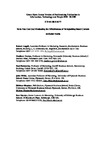News You Can Use! Evaluating the Effectiveness of Newsjacking Based Content on Social Media
| dc.contributor.author | Angell, R | |
| dc.contributor.author | Bottomley, P | |
| dc.contributor.author | Gorton, M | |
| dc.contributor.author | White, John | |
| dc.contributor.author | Bhaskar, S | |
| dc.contributor.author | Marder, B | |
| dc.date.accessioned | 2019-09-02T14:00:04Z | |
| dc.date.issued | 2019-10-28 | |
| dc.identifier.issn | 0959-3845 | |
| dc.identifier.issn | 1758-5813 | |
| dc.identifier.uri | http://hdl.handle.net/10026.1/14859 | |
| dc.description.abstract |
Purpose Newsjacking (real-time deployment of news stories in communications) is now ubiquitous for brands using social media. Despite its pervasiveness, little analysis of its effectiveness exists. The purpose of this paper is to test if newsjacking positively influences various consumer responses (attitude toward content, brand attitude and purchase intent). Taking an audience perspective supported by the elaboration likelihood model, the research also establishes if a higher level of news involvement, as well as an ability to recognize the story behind the content, enhances the effectiveness of newsjacking content. Design/methodology/approach An experimental design using taglines (newsjacking vs non-topical content) from a real BMW campaign was tested on a sample of 252 consumers. Three research questions pertaining to the effectiveness of newsjacking were specified and analyzed within a structural equation modeling framework. Findings The findings support the conclusion that newsjacking is an effective communication tool. More favorable consumer responses were elicited in the newsjacking condition, as compared to content deploying a non-topical tagline. In addition, recipients reporting a higher level of news involvement rated the content more favorably in the newsjacking (vs the non-topical) condition. Deploying news stories that are more recognizable increases the chances of successful newsjacking. Messages received by those with higher product involvement (category level: cars) were more effective regardless of the type of the appeal. Originality/value The authors contribute to the communications and social media literatures by investigating the effectiveness of an emerging but popular tactic leveraged by content creators. The work builds upon the limited research that has tested consumer responses to newsjacking. From a practical perspective, the research provides insight into the type of audience and situations most likely to yield a favorable outcome from newsjacking. | |
| dc.format.extent | 755-773 | |
| dc.language | en | |
| dc.language.iso | en | |
| dc.publisher | Emerald | |
| dc.subject | Brands | |
| dc.subject | Social media | |
| dc.subject | Technology | |
| dc.subject | E-marketing | |
| dc.subject | Phenomenon | |
| dc.subject | Content management | |
| dc.subject | Study setting | |
| dc.title | News You Can Use! Evaluating the Effectiveness of Newsjacking Based Content on Social Media | |
| dc.type | journal-article | |
| dc.type | Journal Article | |
| plymouth.author-url | https://www.webofscience.com/api/gateway?GWVersion=2&SrcApp=PARTNER_APP&SrcAuth=LinksAMR&KeyUT=WOS:000530669700013&DestLinkType=FullRecord&DestApp=ALL_WOS&UsrCustomerID=11bb513d99f797142bcfeffcc58ea008 | |
| plymouth.issue | 2 | |
| plymouth.volume | 33 | |
| plymouth.publication-status | Published | |
| plymouth.journal | Information Technology and People | |
| dc.identifier.doi | 10.1108/ITP-04-2019-0177 | |
| plymouth.organisational-group | /Plymouth | |
| plymouth.organisational-group | /Plymouth/Faculty of Arts, Humanities and Business | |
| plymouth.organisational-group | /Plymouth/Faculty of Arts, Humanities and Business/Plymouth Business School | |
| plymouth.organisational-group | /Plymouth/REF 2021 Researchers by UoA | |
| plymouth.organisational-group | /Plymouth/REF 2021 Researchers by UoA/UoA17 Business and Management Studies | |
| plymouth.organisational-group | /Plymouth/Users by role | |
| plymouth.organisational-group | /Plymouth/Users by role/Academics | |
| dcterms.dateAccepted | 2019-08-30 | |
| dc.rights.embargodate | 2019-12-11 | |
| dc.identifier.eissn | 1758-5813 | |
| dc.rights.embargoperiod | Not known | |
| rioxxterms.versionofrecord | 10.1108/ITP-04-2019-0177 | |
| rioxxterms.licenseref.uri | http://www.rioxx.net/licenses/all-rights-reserved | |
| rioxxterms.type | Journal Article/Review |


